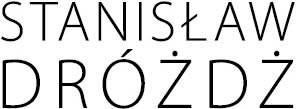

AUTHOR | WORK
do not read, Tadeusz Sławek
When Stanisław Dróżdż instructs us in the imperative mode ‘Do not read!’, we continue to move within the closed circuit of concrete poetry limited by ‘the hardness’ of the material which dictates the reader its conditions (the author himself refers to the problem of ‘the self-determination’ of the material) and by the viewers’ inclination to interpret the text on their own conditions. Here comes another important tension which appears in the visual texts by Stanisław Dróżdż: the conflict between the autonomy of the text and the autonomy of the reader, between the liberty of the sign and that of the human being. The viewers/readers are sentenced to wander between two types of freedom: they cannot and do not want to give away their own freedom but owing to the fact that they remain lonely and that the work is overwhelmed by the light of reflection, the reader can admit that the text is free.
The untitled text from the year 1971 demands us ‘not to read’ (which is the requirement of freedom). However, we can become aware of its freedom only when we cease to be faithful to our freedom, namely we read a text which requires no reading. Only having read it do we find out that we were supposed not to read it. Another order is impossible. Therefore, according to Dróżdż, reading is a violation of the text’s freedom in the name of the reader’s freedom in order to, eventually, give priority to the former.
[…]
Do not read! finally illustrates (in the historical sense of this verb, which signified ‘pouring with the beam of light, making visible, lighting’) the same problem which was addressed by ‘the word’ in the aforementioned work by Dróżdż. The problem can be briefly described as an incongruence of sign and object. On this level, while reading a text which says ‘Do not read!’ we do not commit any heresy as ‘not reading’ is something different from the signs which form the three words ‘Do not read!’. In this sense, we may ‘not read’ while reading as we read only the signs which do not have anything in common with not reading in terms of their entity.
The lesson in this field given to us by concrete poetry is austere: something is something which it really is, while the sign may only be an act of infinite approaching what this ‘something’ really is. The sign and the object are two diverse entities. When applying words, we may travel in 80 days around the object without but once going inside it.
A fragment of an essay The Art of Wise Concrete Fact, [in:] Tadeusz Sławek, In-Between Letters, Wydawnictwo Dolnośląskie, Wrocław 1989.